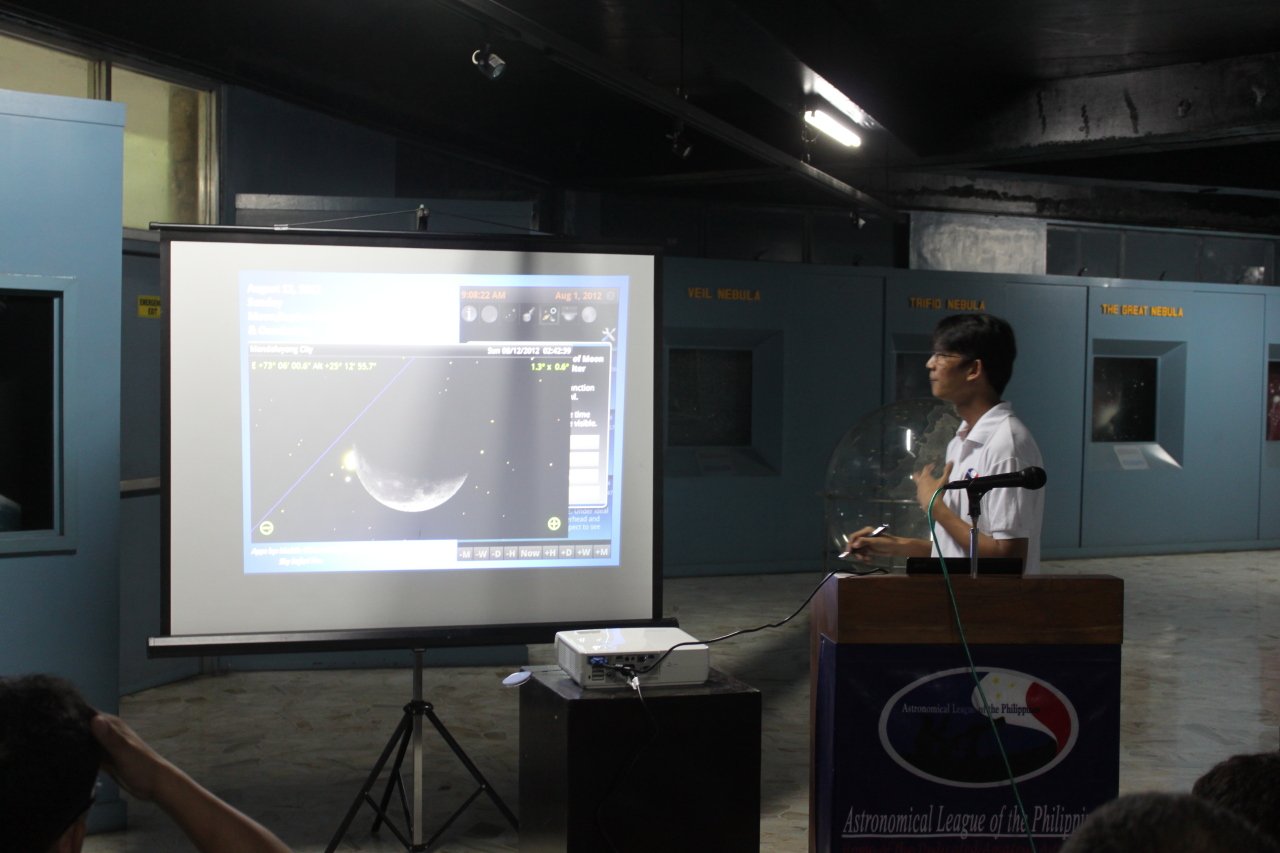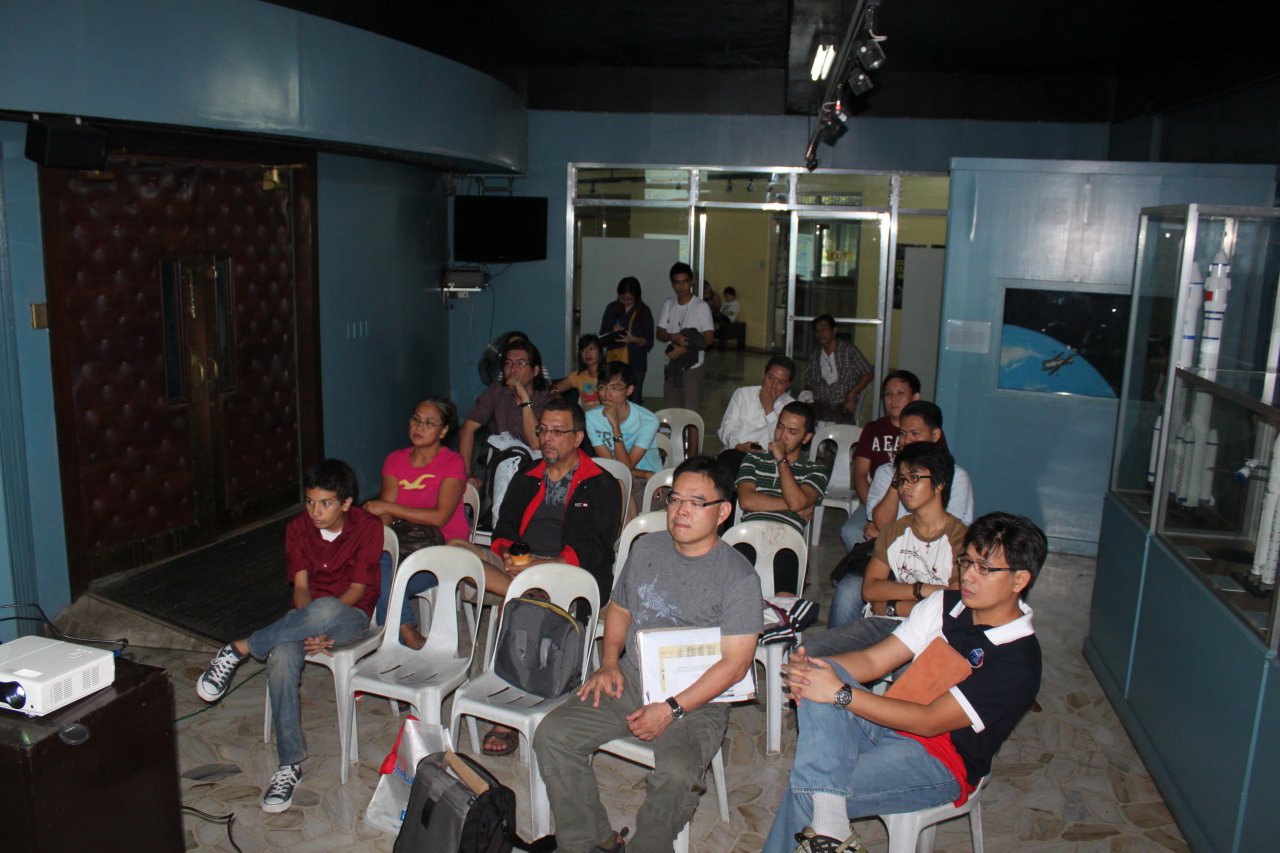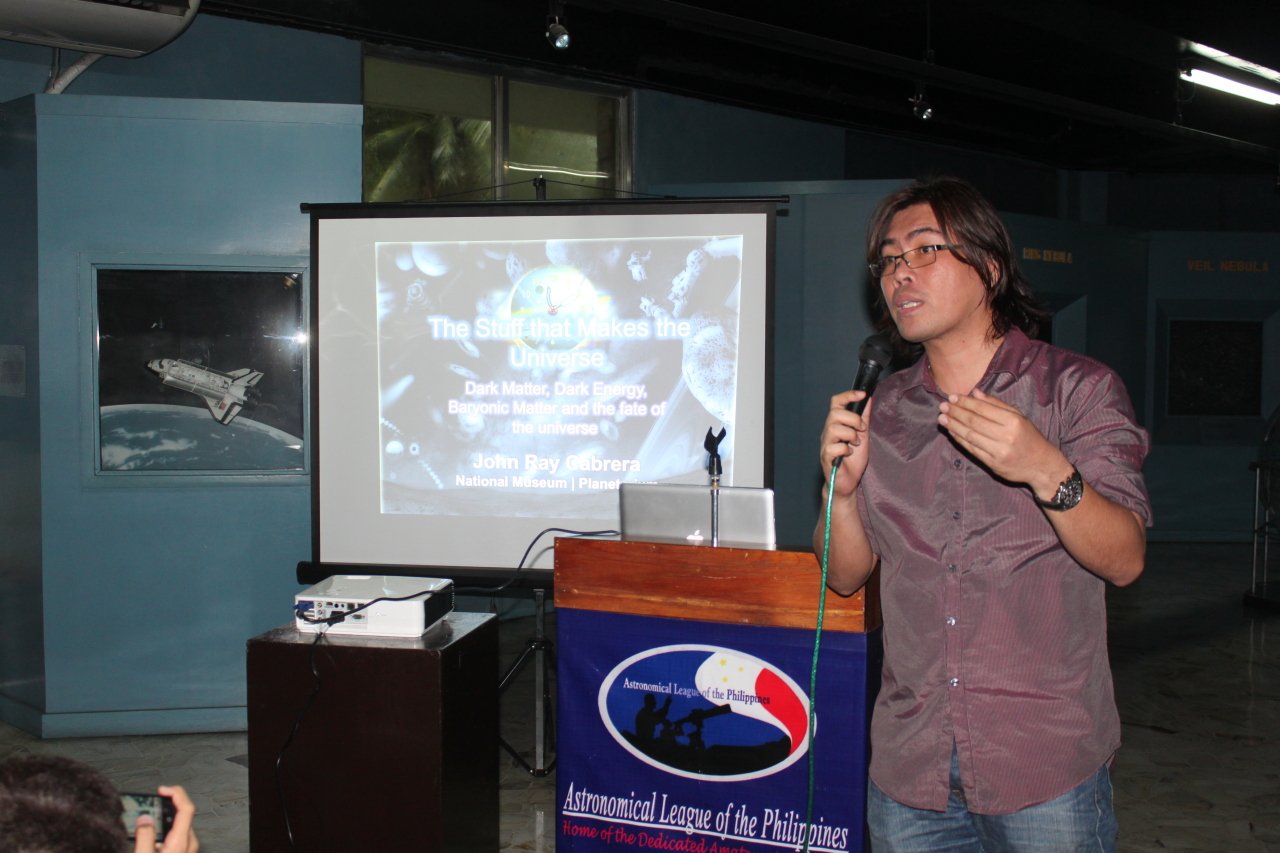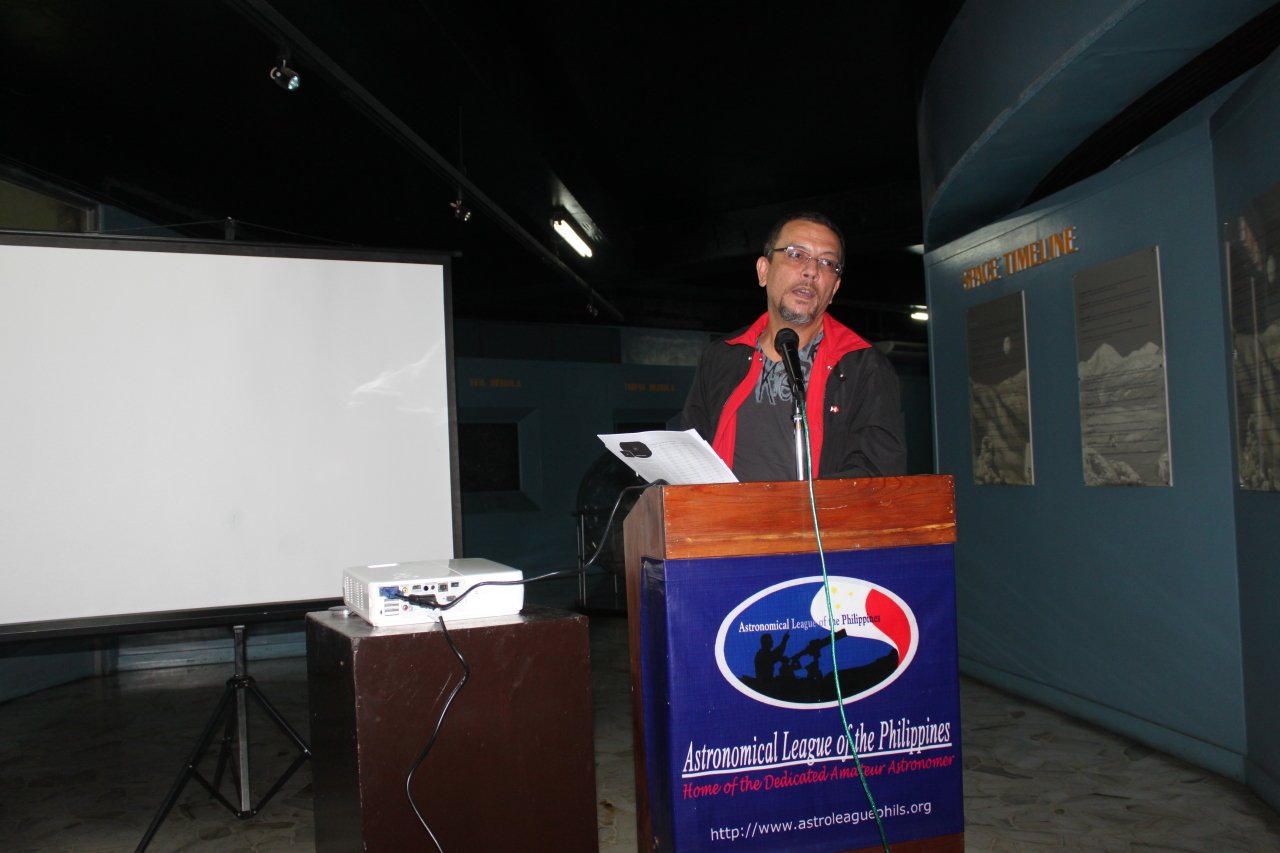August 5, 2012 ALP Monthly
Meeting Report
by James
Kevin Ty , Christopher Louie Lu and John Ray
Cabrera
Images by James Kevin Ty
Last August 5,
members of the Astronomical League of the Philippines
(ALP) held their monthly meeting at Manila
Planetarium. Members who
attended were ALP President James Kevin Ty , Charito and son Kendrick Cole KC Ty
, Secretary Christopher
Louie Lu , Treasurer Andrew Ian Chan , directors
Edgar Ang, John Ray Cabrera, Alfonso Uy and Christopher
Lee ; Liza
Quitlong, Ma. Belen Pabunan , Nel Lagda , Jan Karlo Hernandez, Ronald Sison
, Jerome Clemente, Gary Andreassen , wife
Irma and son Steinar Andreassen , Norman Marigza , Jan
Karlo Hernandez , Marv Gulapa , Mark Ian Singson &
Cristina Decena.
Meeting proper started at
around 3:30pm with ALP Secretary Christopher Louie
Lu discussing on the August 12, 2012 Jupiter-Moon
Occultation & Perseid Meteor Shower Observation as well
as the August 6 Mars Science Laboratory (MSL) landing
date. Below is his sypnosis of the
Mars Science Laboratory Mission.
Mars Science
Laboratory (MSL) is a robotic mission to Mars launched
by NASA that will attempt to land a Mars rover called
Curiosity on the surface of Mars. Launched on Nov. 26,
2011, Curiosity is currently en route to the planet
Mars, it is scheduled to land in Gale Crater at about
05:31 UTC on August 6, 2012.
Specifications:
The Curiosity rover will weigh only 900 kg (2,000 lb)
including 80 kg (180 lb) of scientific instruments. The
rover is 3 m (9.8 ft) in length, approximately the size
of Mini Cooper automobile, much larger than the Mars
Exploration Rovers, which have a length of 1.5 m (4.9
ft).
Curiosity will be able to roll over obstacles
approaching 75 cm (30 in) in height. Maximum
terrain-traverse speed is estimated to be 90 m (300 ft)
per hour by automatic navigation; average traverse
speeds will likely be about 30 m (98 ft) per hour, based
on variables including power levels, terrain difficulty,
slippage, and visibility. MSL is expected to traverse a
minimum of 19 km (12 mi) in its two-year mission.
Curiosity is powered by a radioisotope thermoelectric
generator (RTG), like the successful Viking 1 and Viking
2 Mars landers in 1976. The two identical on-board rover
computers, called "Rover Compute Element" (RCE), contain
radiation-hardened memory to tolerate the extreme
radiation from space and to safeguard against power-off
cycles.
Curiosity has two means of communication – an X band
transmitter and receiver that can communicate directly
with Earth, and a UHF Electra-Lite software-defined
radio for communicating with Mars orbiters.
Communication with orbiters is expected to be the main
path for data return to Earth, since the orbiters have
both more power and larger antennas than the lander.
The Mars Science Laboratory mission is part of NASA's
Mars Exploration Program, a long-term effort for the
robotic exploration of Mars, and the project is managed
by the Jet Propulsion Laboratory of California Institute
of Technology.The total cost of the MSL project is about
US$2.5 billion.
Mission Goals & Objectives:
The MSL
mission has four scientific goals:
1) Determine whether Mars could ever have supported life
2) Study the climate of Mars
3) Study the geology of Mars
4) Plan for a human mission to Mars
To contribute to these goals, MSL has six main
scientific objectives:
1) Determine the mineralogical composition of the
Martian surface and nearsurface geological materials.
2) Attempt to detect chemical building blocks of life (biosignatures).
3) Interpret the processes that have formed and modified
rocks and soils.
4) Assess long-timescale (i.e., 4-billion-year) Martian
atmospheric evolutionprocesses.
5) Determine present state, distribution, and cycling of
water and carbon dioxide.
6) Characterize the broad spectrum of surface radiation,
including galacticradiation, cosmic radiation, solar
proton events and secondary neutrons.

ALP Secretary
Christopher Louie Lu discussed on the August 12,
2012 Jupiter-Moon Occultation & Perseid Meteor
Shower Observation as well as the August 6 Mars
Science Laboratory (MSL) mission. |

ALPers listen to the
interesting topics presented by ALPers Christopher
Louie Lu and John Ray Cabrera. |

ALP director John Ray
Cabrera gave an interesting lecture entitled
The Stuff that Makes the Universe (Dark Matter, Dark
Energy, Baryonic Matter, and the Fate of the
Universe) |

ALPer Gary Andreassen
distributed some guides on double star observation
project by Sissy Haas which can be done by members
with any scopes they owned, |
ALP director John Ray Cabrera
was next to give an interesting lecture entitled The
Stuff that Makes the Universe (Dark Matter, Dark Energy,
Baryonic Matter, and the Fate of the Universe). His
synopsis on the lecture can be found below:
The lecture posits on the understanding of particle
formation from the time when four forces of nature
collapses at the onset of a Big Bang Nucleosynthesis.
The particles after the temperature of the cosmos cooled
down, giving rise to requisite elements for the advent
of stellar birth and galactic clusters and ultimately to
what is known today as our Universe.
However, the mass component of
the baryonic matters is not enough to account for the
total mass volume of the universe. Simple Newtonian
physics suggests that objects located even at the
outskirts of the galaxy rotates with seemingly high
angular momentum in its orbital path as with the objects
near the mass concentration/luminous bulge. Thus a Dark
Matter is taken into account, comprising 23% of the
cosmic components. It was found out that the role of the
Dark Matter is to clump clusters of galaxies together so
that its circumnavigating objects local to the
respective galaxies will not smear out of its structure.
Observational evidence for the presence of the Dark
Matter includes red shifting of Type 1A Supernovae,
gravitational lensing, and the data obtained from the
Chandra X-Ray observatory. CDMS(Cryogenic Dark Matter
Search) was also launched to hunt for the elusive Dark
Matter.
Dark Energy on the other hand
is the energy of the vacuum that stretches the fabric of
space and time in exponential rate. Dark Energy, on a
mathematical sense, is essentially a positive energy
density with a negative pressure. Two models were taken
into consideration for its explanation, Quintessence and
Quantum Fluctuation. By Heisenberg Uncertainty
Principle, when the conservation of energy is
temporarily violated, it left an energy density hole in
the vacuum. Dark Energy is said to be the downright
victor in the tug-of-war of the Dark Matter and Dark
Energy pulling against its other because of the 70%
measured volume of the Dark Energy.
In the understanding of the
fate of the universe, five ages were tackled. Primordial
Era – where subsequent inflation and recombination of
electrons took place, Stelliferous Era – the current era
where galaxies and stars are formed, Degenerate Era –
the cosmological epoch where stars lost its fuel,
habituated by neutron stars, brown dwarfs, and white
dwarfs, Black Hole Era – where organized matter were
just in a form of Black Holes, and Dark Era – where the
universe has been vasty stretched out, with only
diffused particle left such as long microwave photons,
electrons and positrons occasionally forming positronium
atoms. The universe started out as a particle, and
ultimately ends up with it.
Afterwards , ALPer Gary
Andreassen distributed some guides on double star
observation project by Sissy Haas which can be done by
members with any scopes they owned and invited all to
test out the interesting project. Lastly, ALP President James
Kevin Ty informed members of possible group observation
of the August 12, 2012 Jupiter
occultation by the Moon at PAGASA observatory in case
weather is good or else it will be an individual
observations. Meeting ended at around 6:00pm.
|